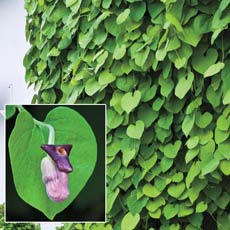
Aristolochia macrophylla – Dutchman’s Pipe
Host Plant – Pipevine Swallowtail
Culture
Easily grown in average, medium, well-drained soil in full sun to part shade. Prefers rich, moist soil. Intolerant of dry soils. Cut back in late winter to control growth. Grows well from seed.
Noteworthy Characteristics
This deciduous, woody, climbing vine is an eastern American native which typically occurs in the wild in rich, moist woods and along streams. Can rapidly grow to 20-30′. An old-fashioned favorite that is grown for its large, heart-shaped, densely overlapping leaves (6-12″ long) which can quickly cover an arbor or trellis with attractive, glossy, deep green foliage. Commonly called Dutchman’s pipe because the unusual, 2″ long, yellowish-green flowers (each flaring at the calyx mouth to form 3 brownish-purple lobes) superficially resemble Dutch smoking pipes. Although the flowers make interesting conversation pieces, they are usually hidden by the dense foliage and are somewhat inconspicuous.
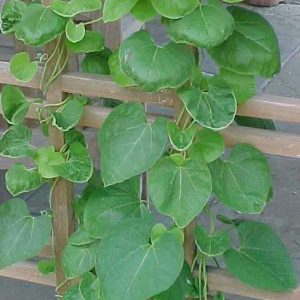
Aristolochia tomentosa – Dutchman’s Pipe
Host Plant – Pipevine Swallowtail
Aristolochia tomentosa, commonly known as Wooly Pipevine, is a species of Dutchman’s pipe. It is a large, woody and twining vine native to the Midwest and Southeast. It can be found on stream banks, flood plains and bottomlands and is known to climb trees and shrubs, growing to a height of 20-30’ tall, making it an excellent choice for arbors, trellises and fences. The leaves of this species are quite large, heart-shaped and hairy. Aristolochia tomentosa is a larval plant for the Pipevine Swallowtail butterfly. All plants are grown without pesticides and are safe for developing larvae. Ships in 4.5″ perennial pot.
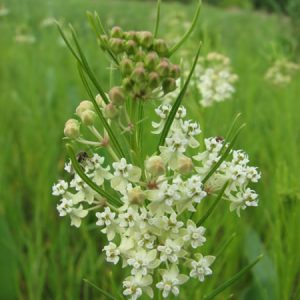
Asclepias verticillata – Whorled Milkweed
Asclepias verticillata
Asclepias verticillata Whorled Milkweed is a Michigan Native and one of the most broadly distributed of all milkweeds in the United States . It likes dry sandy, clayey or rocky soil in sun or part shade and can be found growing in a variety of environments from hill prairies to woodland openings. It is listed as rare or threatened in some of its northeastern range.
This petite milkweed blooms later in the year than most milkweed and is a common late season host plant for Monarch larvae. Flowers are white to greenish white and attract many insects including butterflies and bees. It is deer and rabbit-resistant. Also known as Horsetail Milkweed.
*Available late May.
Grown in 4.5″ square pot.
All of our plants are grown without the use of harmful pesticides and are safe for developing larvae.
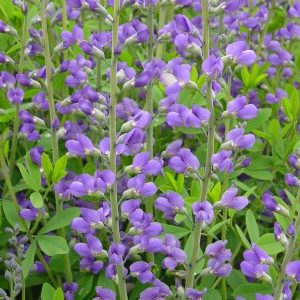
Baptisia australis – Blue False Indigo
Wild Indigo Duskywing / Eastern Tailed-Blue / Orange Sulphur / Clouded Sulphur / Frosted Elfin / Hoary Edge
Blue spikes of pea-shaped flowers resemble the tall racemes of lupines in May and early June. A slow to mature, but very rewarding native garden perennial. Found in open woods, river banks and sandy floodplains, New York to Nebraska to Georgia.
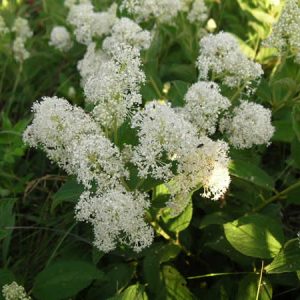
Ceanothus americanus – New Jersey Tea
Host Plant – Eastern Tailed Blue / Spring Azure / Summer Azure
A deciduous shrub that grows just 3′ tall, the dried leaves of New Jersey Tea make a flavorful tea that was popular during the Revolutionary War. This extremely adaptable species can withstand inhospitable conditions because of massive, deep roots.
The white flower poms are attractive to butterflies, hummingbirds and pollinators.
New Jersey Tea is excellent as a shrub border and a is a fabulous addition for native plant gardens. It is also effective as a shrubby ground cover for hard-to-grow areas such as dry rocky slopes and banks. Easily grown in average, dry to medium, well-drained soils in full sun to part shade. Best in sandy loams or rocky soils with good drainage. Thick, woody, red roots go deep and help plant withstand droughty conditions, but make established shrubs difficult to transplant.
Grown in one quart pot with approximately 6” of top growth.
Plants grown without harmful pesticides and are safe for butterfly gardens.
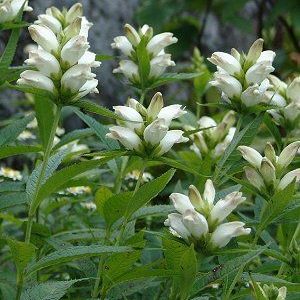
Chelone glabra – White Turtlehead
Host Plant – Baltimore Checkerspot
Spikes of elegant white flowers top shiny green foliage in late summer and early fall. Grows best in moist meadows, stream banks, and swamps. Favorite breeding site for the Baltimore Checkerspot Butterfly.

Ruellia humilis – Wild Petunia
Host plant – Common Buckeye Butterfly
Wild petunia occurs in dryish soils in open woods, glades, prairies and fields throughout the State except for the far southeastern lowlands. Typically grows to 2′ tall. Features tubular, bell-shaped, petunia-like flowers (to 3″ long), each with five shallow rounded lobes. May to October bloom period. Lavender to lilac flowers appear singly or in clusters in the upper leaf axils. Oblong to lanceolate, olive green leaves to 4″ long. Leaves and stems are hairy. This plant in on threatened list in the state of Michigan.
Available for shipping mid May
